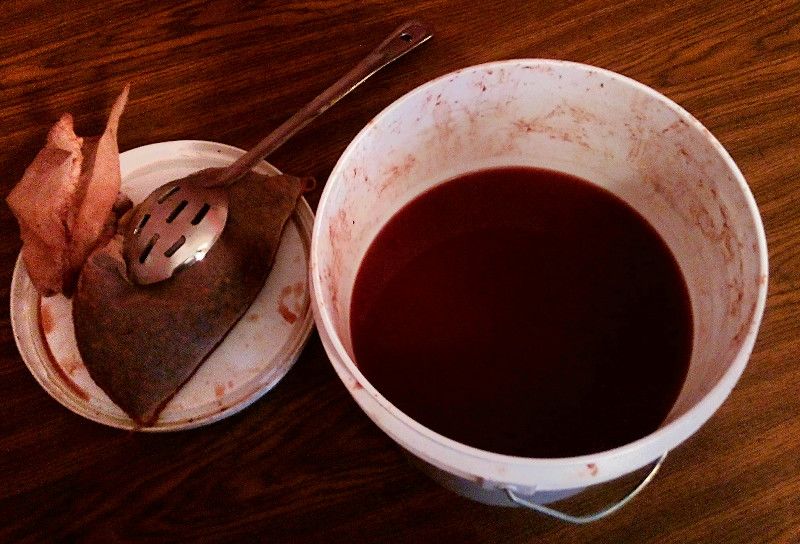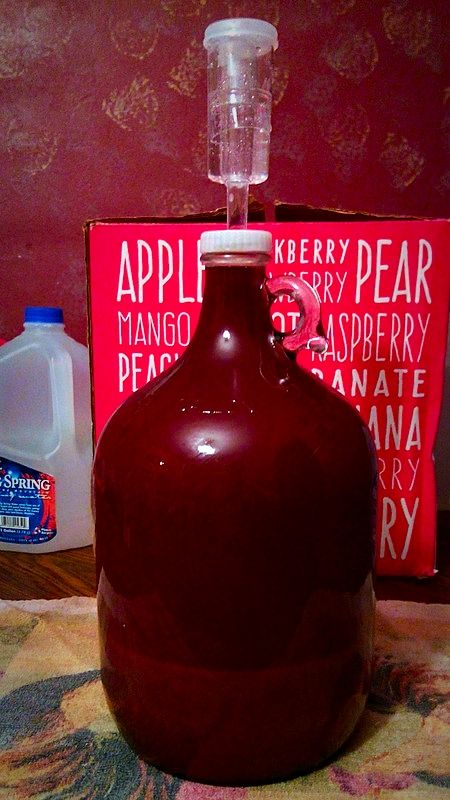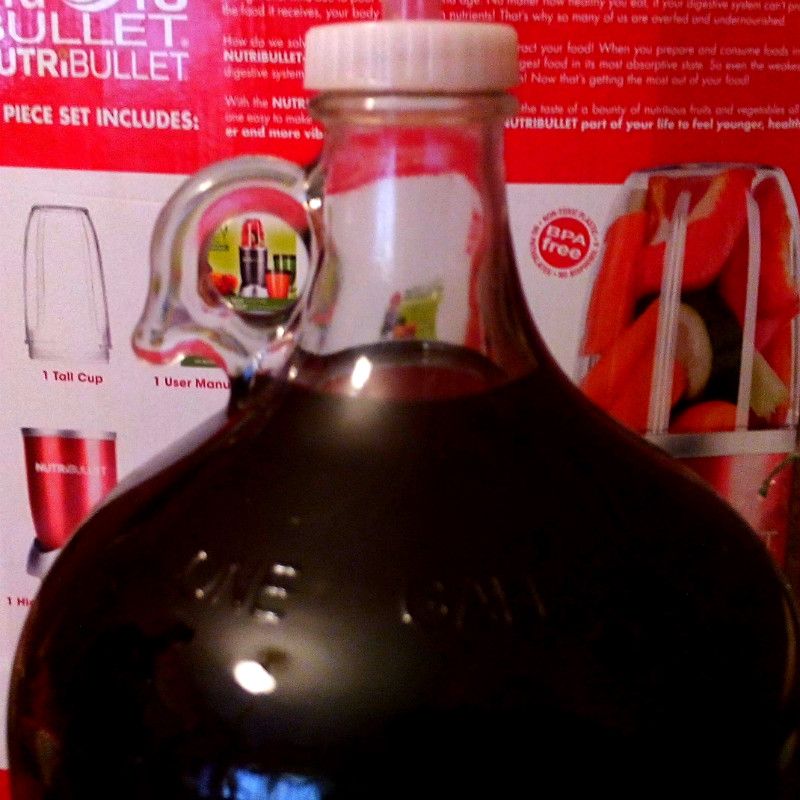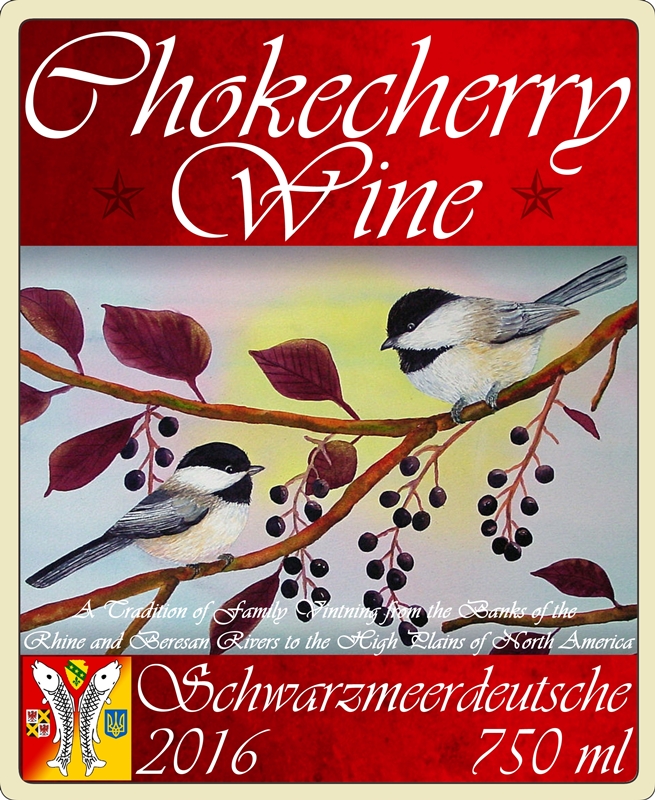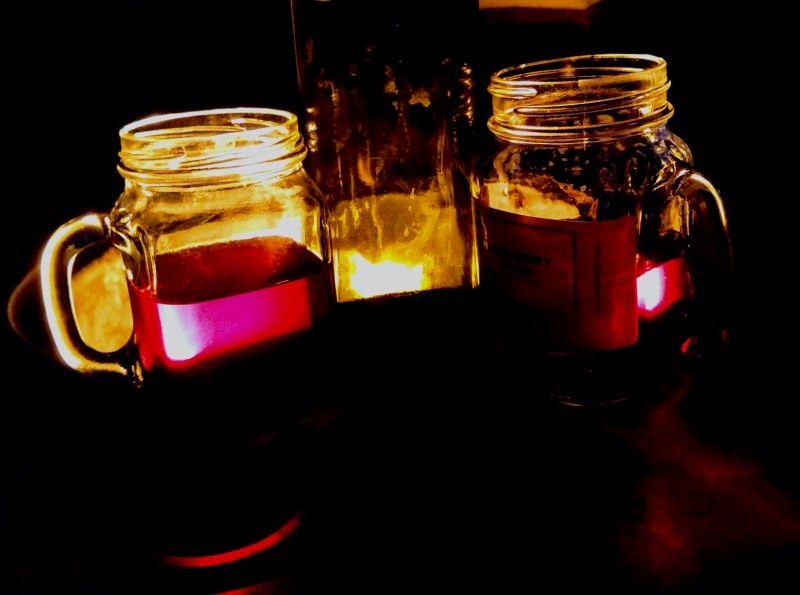TasunkaWitko
Well-Known Member
Chokecherry Wine - My First Attempt
Those of us who live in “Chokecherry Country” know that we have a great thing going with these wonderful little spheres of purplish-black love, known scientifically as Prunus virginiana. Chokecherries are an integral part of the culture and the people who live with them, from the Native American tribes who gathered and used them hundreds (and probably thousands) of years ago, to the pioneers and settlers who arrived to tame the land and discovered an irresistible treat waiting for them when they arrived.
All my life, I’ve enjoyed chokecherries, mostly in the form of syrup and jelly, but occasionally in a few other creative ways. Late last year, I even brewed a chokecherry-wheat ale that came out really well, and I intend to brew it again later this year. But in spite of the fact that I have lived in Montana and the Dakotas all of my life, one of the most popular ways to experience the chokecherry is one that I had never tried before - in wine.
Last year, I set out to remedy that situation when I picked several pounds of chokecherries in the mountains south of home with my youngest son. It was one of those late-summer mornings that exist to let you know that autumn is approaching; cool, foggy and with occasional drizzles of light rain. The aroma of wet leaves and grass was heavy in the air, and in many ways, it was nearly a perfect time to be where I was and doing what I was doing. Interestingly, the chokecherries proved to be difficult to find last year, due to a late-spring frost; however, after much searching outside of our usual areas, we did find a couple of nice groves that contained a wonderful harvest of plump, ripe chokecherries. I made some of them into syrup, and I used a small portion for the aforementioned chokecherry-wheat ale that I brewed...and the rest eventually became my first attempt at chokecherry wine.
The Wonderful, Thoughtful and Beautiful Mrs. Tas, knowing my desire to learn about making wine, bought this 1-gallon kit for my last birthday:
http://mastervintner.com/master-vintner-fresh-harvest-fruit-winemaking-kit/
What I especially like about this kit is that it simply contains the equipment and necessary additives for making wine; the beauty of it is that you get to supply all of your own fruit for making it, and it can be whatever you want. You can get it at the market, grow it in your garden...or you can gather what Nature provides. The possibilities are endless, and I am grateful to her for choosing this option, because I feel that it would be much more rewarding to go this route, than to make a “normal” wine using pre-packaged ingredients from a factory somewhere. This type of venture appeals to me, a descendant of immigrants, farmers, gardeners and gatherers going all the way back through their migrations to their origins; Montana, North Dakota, Ukraine, The Black Forest Region of Germany, and finally to 18th Century Alsace - and before that, as well.
There are probably hundreds of different recipes for chokecherry wine out there on hand-written notecards and in kitchen cupboards all across the northern United States and Southern Canada, often written with vague, generalised instructions using archaic terminology or esoteric-sounding directives such as “soak chokecherries in water until a white film grows over them, then add bread yeast.” There are also quite a few recipes to be found on the internet; however, it seemed to me that many of those recipes will contain blends with other fruits or wines, or that they call for the wine to be infused with additives, adjuncts and other ingredients that are - in my opinion - distractions from the true character of the chokecherry. In most cases, the recipes that I found are for very large batches of wine, calling for 50 or 60 pounds of chokecherries at a time and methods that could almost be on an industrial scale. Even most of the smaller recipes were for a minimum of 20 gallons of wine, an amount that would take me decades to consume.
For my own requirements, a small, low-maintenance, home-based batch that would be typical of any rural farmhouse wine, there were a few recipes out there; all were similar, but there were differences in the details that were enough to be a bit confusing for someone who has never made “real” wine before. Luckily, I found salvation in the form of a friendly and helpful woman on this forum that we all know as "Yooper.” Being from the Midwest, she has been making chokecherry wine for many years; consequently, she is very well-versed on the fundamentals of the process, the pitfalls and the dozens of other little things that will really help someone who is starting out. Thanks to her experience and mentorship, I was able to bring some order to the chaos and finally get this project started after several years of wandering around aimlessly in the wilderness. I am very grateful to her for all of her patient and valuable help with this project!
Here is her recipe, scaled down to 1 gallon:
Here’s how my first batch of wine came together (deviations from Yooper’s original recipe are in parenthesis, for comparison):
At the time of this writing, I am still in the beginning stages of fermentation. I will keep a record of my progress here on this thread as I learn what I am doing. This will serve the dual purpose allowing me to retrace my steps next time - adjusting when necessary - while also (hopefully) providing useful information for anyone who is wanting to start their own batch of chokecherry wine. This and subsequent posts will contain terminology that might be new to those who have not made wine before; to be honest, I am still learning many of these terms myself, so my understanding of them is still rather superficial. I might know some definitions, but it will take more experience before I am able to grasp the context of and interrelationships between many fundamental aspects of home winemaking. I will do my best to explain some of these terms when and where I can. If you have questions, please be sure to ask, or to consult many of the excellent resources available.
Here is a record of my progress up until this point:
Those of us who live in “Chokecherry Country” know that we have a great thing going with these wonderful little spheres of purplish-black love, known scientifically as Prunus virginiana. Chokecherries are an integral part of the culture and the people who live with them, from the Native American tribes who gathered and used them hundreds (and probably thousands) of years ago, to the pioneers and settlers who arrived to tame the land and discovered an irresistible treat waiting for them when they arrived.
All my life, I’ve enjoyed chokecherries, mostly in the form of syrup and jelly, but occasionally in a few other creative ways. Late last year, I even brewed a chokecherry-wheat ale that came out really well, and I intend to brew it again later this year. But in spite of the fact that I have lived in Montana and the Dakotas all of my life, one of the most popular ways to experience the chokecherry is one that I had never tried before - in wine.
Last year, I set out to remedy that situation when I picked several pounds of chokecherries in the mountains south of home with my youngest son. It was one of those late-summer mornings that exist to let you know that autumn is approaching; cool, foggy and with occasional drizzles of light rain. The aroma of wet leaves and grass was heavy in the air, and in many ways, it was nearly a perfect time to be where I was and doing what I was doing. Interestingly, the chokecherries proved to be difficult to find last year, due to a late-spring frost; however, after much searching outside of our usual areas, we did find a couple of nice groves that contained a wonderful harvest of plump, ripe chokecherries. I made some of them into syrup, and I used a small portion for the aforementioned chokecherry-wheat ale that I brewed...and the rest eventually became my first attempt at chokecherry wine.
The Wonderful, Thoughtful and Beautiful Mrs. Tas, knowing my desire to learn about making wine, bought this 1-gallon kit for my last birthday:
http://mastervintner.com/master-vintner-fresh-harvest-fruit-winemaking-kit/
What I especially like about this kit is that it simply contains the equipment and necessary additives for making wine; the beauty of it is that you get to supply all of your own fruit for making it, and it can be whatever you want. You can get it at the market, grow it in your garden...or you can gather what Nature provides. The possibilities are endless, and I am grateful to her for choosing this option, because I feel that it would be much more rewarding to go this route, than to make a “normal” wine using pre-packaged ingredients from a factory somewhere. This type of venture appeals to me, a descendant of immigrants, farmers, gardeners and gatherers going all the way back through their migrations to their origins; Montana, North Dakota, Ukraine, The Black Forest Region of Germany, and finally to 18th Century Alsace - and before that, as well.
There are probably hundreds of different recipes for chokecherry wine out there on hand-written notecards and in kitchen cupboards all across the northern United States and Southern Canada, often written with vague, generalised instructions using archaic terminology or esoteric-sounding directives such as “soak chokecherries in water until a white film grows over them, then add bread yeast.” There are also quite a few recipes to be found on the internet; however, it seemed to me that many of those recipes will contain blends with other fruits or wines, or that they call for the wine to be infused with additives, adjuncts and other ingredients that are - in my opinion - distractions from the true character of the chokecherry. In most cases, the recipes that I found are for very large batches of wine, calling for 50 or 60 pounds of chokecherries at a time and methods that could almost be on an industrial scale. Even most of the smaller recipes were for a minimum of 20 gallons of wine, an amount that would take me decades to consume.
For my own requirements, a small, low-maintenance, home-based batch that would be typical of any rural farmhouse wine, there were a few recipes out there; all were similar, but there were differences in the details that were enough to be a bit confusing for someone who has never made “real” wine before. Luckily, I found salvation in the form of a friendly and helpful woman on this forum that we all know as "Yooper.” Being from the Midwest, she has been making chokecherry wine for many years; consequently, she is very well-versed on the fundamentals of the process, the pitfalls and the dozens of other little things that will really help someone who is starting out. Thanks to her experience and mentorship, I was able to bring some order to the chaos and finally get this project started after several years of wandering around aimlessly in the wilderness. I am very grateful to her for all of her patient and valuable help with this project!
Here is her recipe, scaled down to 1 gallon:
Due to several factors, including my father’s recollections from watching his own father make chokecherry wine years ago, my attempt was slightly different; however, It seems that the essentials should be close enough to get things started so that I can learn what I am doing and why I am doing it. My goal was for a slightly- (but not overly-) sweet, fruity wine that has plenty of rich, chokecherry flavour. Once I am able to see the results of this batch, I will be able to adjust toward that end, if necessary.Yooper’s Chokecherry Wine
2-1/2 pounds chokecherries
2 pounds table sugar
1 tsp acid blend
1/2 tsp pectic enzyme
1/4 tsp grape tannin (or less)
1 tsp yeast nutrient
1 crushed Campden tablet
Champagne yeast
Freeze berries first, for ease in crushing, but no need to destone. Place in a sanitized mesh nylon bag (very large so the berries have room), and then bring approximately 6 pints of water to a boil, and add 1.5# of sugar. Stir in acid blend, grape tannin, yeast nutrient, and crushed campden tablet. Pour over the berries. Stir well, cover loosely and let stand 12 hours. Add pectic enzyme and let stand another 12 hours. Stir well, estimate volume (you will be removing the chokecherry pulp, so I lift out the bag and look at the volume in the primary bucket). Check the SG (Specific gravity) to ensure it is between 1.085-1.100. Write this number down. Add yeast, stir and cover again.
Gently squeeze bag twice daily to extract juice. After five days, drain bag and squeeze well to extract as much juice as you can. Rack to secondary, and fit airlock. If the original SG was low, this is the time to add additional sugar to boost the ABV. Rack when lees are 1/4" thick, or in about 30 days. After that, rack whenever lees are 1/4" thick, or if there are any lees at all in 60 days.
After no new lees fall after at least 60 days, and the wine is clear, it can be stabilized and sweetened if desired, or racked onto oak for a period of time for a table wine.
I would miss the grape concentrate in this, so I would add a few raisins in secondary for body and flavor.
In a batch about 5 years ago, I got an SG of 1.094 from 8 pounds of sugar in 5 gallons, so I'd start low (the 1.5 pound above) and add more later if necessary. The batch the following year needed 12 pounds of sugar in a 6 gallon batch, so you can see how much it varies!
Here’s how my first batch of wine came together (deviations from Yooper’s original recipe are in parenthesis, for comparison):
I began my chokecherry wine on Saturday, February 27th, 2016. Since beginning this project, I have been trying to follow the basic procedure outlined in Yooper’s instructions, but there have been a couple of minor differences. With my work and home schedule, I’ve only been able to stir the chokecherry must once each day, rather than twice. Another difference is that I’ve never used a hydrometer before and don’t yet have all of what I need to use one in order to check specific gravity, final gravity etc.; I’ve since ordered the modest equipment that I need, so I will have it by the next time I start a batch of wine. This will help me keep better track of what my wine is doing at various stages of its progress, and will allow me to accurately measure the alcohol content, as well.Ron’s Chokecherry Wine (First Attempt):
2.9 pounds chokecherries (2.5 pounds in original recipe, but 2.9 is what I had)
1 cup golden raisins (my interpretation of “a few” called for in original recipe)
2.25 pounds sugar (2 pounds in original recipe)
3/4 teaspoon acid blend (1 teaspoon in original recipe)
1/2 teaspoon pectic enzyme
1 teaspoon yeast nutrient
1 crushed Campden tablet
1 pkg Montrachet yeast
7 pints Montana spring water (6 pints in original recipe)
Not used: grape tannin (my dad insisted that his dad never used it, so I tried it his way)
At the time of this writing, I am still in the beginning stages of fermentation. I will keep a record of my progress here on this thread as I learn what I am doing. This will serve the dual purpose allowing me to retrace my steps next time - adjusting when necessary - while also (hopefully) providing useful information for anyone who is wanting to start their own batch of chokecherry wine. This and subsequent posts will contain terminology that might be new to those who have not made wine before; to be honest, I am still learning many of these terms myself, so my understanding of them is still rather superficial. I might know some definitions, but it will take more experience before I am able to grasp the context of and interrelationships between many fundamental aspects of home winemaking. I will do my best to explain some of these terms when and where I can. If you have questions, please be sure to ask, or to consult many of the excellent resources available.
Here is a record of my progress up until this point:
Saturday, February 27th, 2016
Well, Glory be ~ I was finally able to start my chokecherry wine today!
My dad, who used to watch his dad make chokecherry wine, came over today telling me about his progress with his own first batch of wine, which he started a couple of days ago. Because of this, I figured that now is the time to finally get going, and I am sure glad that I did. Everything went very smoothly, and I think that I am going to end up with some very nice wine. It actually took longer to get the equipment clean and sanitised than it did to actually get the wine going, so once again, I am kicking myself for taking so long in getting a project started. I could have been sampling some wine right now, If I would have gotten going on it!
Sunday, February 28th, 21016
I did my first stirring and pitched my Montrachet yeast today; I had intended to make a yeast starter, but forgot to do so.
Ambient temperatures are right around 70 degrees, plus or minus a couple of degrees, depending on the time of day.
If I read Yooper's instructions correctly, the primary bucket should be covered loosely (not clamped down) and the airlock should not be on, until it goes into secondary. My dad agrees with this, saying that is how he is doing his.
We're cruising along here, and I think that all is well.
Monday, February 29th, 2016
I stirred my must and squeezed my bag of chokecherries today after work. I was unsure about just how vigorously I should be squeezing things out, so I gave it a few firm squeezes, squishing around so as to hopefully mash up the chokecherries (but not the stones, of course), and then called it good. It did look like a lot of pulpy stuff seeped out of the mesh bag, and I am guessing that by the time my first week is through, I'll have what is essentially a bag of skins and pits.
Temperatures had fallen to 68 degrees, but I am going to guess that this is okay, as long as it was only for a short time. I bumped the heat up and tucked the fermenting bucket away until tomorrow.
The must is looking great, with a characteristic chokecherry colour starting to deepen from purple (with a hint of brown) into deep burgundy. I did not notice any signs of active fermentation, but this is my first batch, so I am not sure what exactly to expect. There were the very beginnings of foam on top, it seemed, so I'll check it tomorrow and see what I have. It is really starting to smell rich as well, almost like the beginning of wine, so I am assuming that I am on the right track.
With my first attempt, I did not add tannin to the recipe, as my dad was insistent that his dad never used it, apparently on the grounds that the few small stems that make it through the picking process provide the necessary tannins. The recipe only calls for 1/4 teaspoon for the gallon, and I am hoping that the wine is not affected in any adverse way. My goal is a rich, slightly-sweet, slightly-fruity wine, so time will tell.
Tuesday, 1 March 2016 (morning)
I looked in on my wine this morning. Ambient temperature was 68 degrees, so I bumped it up just a tiny bit to stay around 70. It was dark in the room, but I think I saw the beginnings of some foam at the top, which I would take as a confirmation of fermentation. It might also have been the mesh bag; I'll know for sure when I get home from work.
I am definitely getting some wonderful, chokecherry-powered aroma from this must, and to me, it definitely SMELLS like fermentation is happening. This is my first batch of any "real" wine, so in many ways I am not sure what to expect. Going forward, I plan to use a hydrometer, as I should have been doing all along, but for now, it seems that things are progressing.
When I get home from work tonight, I'll confirm visual signs of fermentation, stir, squeeze etc.
More as it happens, etc. &c.
As of this morning, 2 March, 2016, things appear to be moving right along. My ambient temperature was 71 degrees when I took a quick peek this morning, and the heart-warming smell of fermenting chokecherries was in the air. I’ll stir tonight when I get home and note any progress.Tuesday, 1 March 2016 (evening)
I came home tonight from work and checked on my wine before stirring it. It looks like things are going well!
Ambient temperatures are holding steady as above, and the wine is getting a nice, deep aroma that definitely has some fermentation in it. Colour remains as described above, a nice deep burgundy with a bare hint of tan or brown added. I still do not see any real foam on top, but maybe I am expecting to see it because of the krausen that I am used to seeing with beer brewing. The wine is quite cloudy now, which is expected, and as I squeezed the mesh bag full of chokecherries, I was getting plenty of good, thick pulp into the bucket. I was also able to feel that about half of the chokecherries are squeezed down to the point where they are pretty much just pits. By Friday, I am guessing that this will be the case for nearly all of the bag, if not all of it.
A few errant drops gave themselves up to a taste test, and I think we've got some good things here. It is actually starting to taste like a young wine; just slightly more sour or acidic than I expected, but I assume that will balance out. There's also plenty of sweetness still, and oodles of chokecherry flavour.
That's all I have for now.


